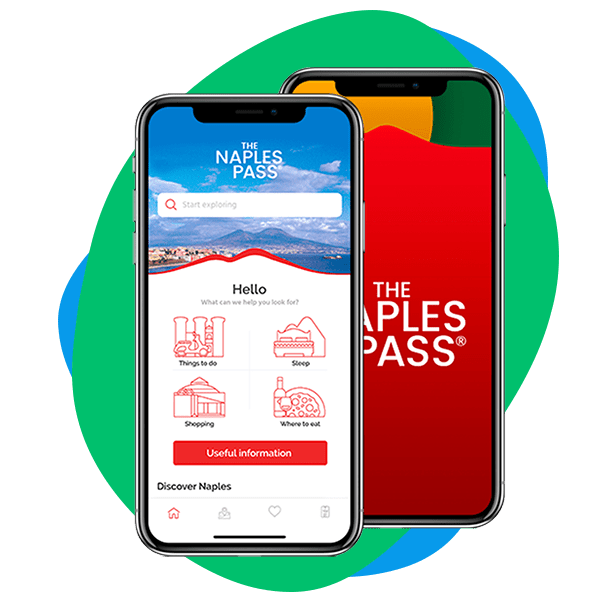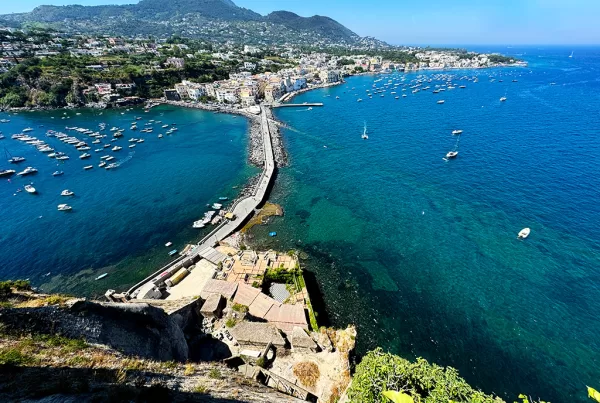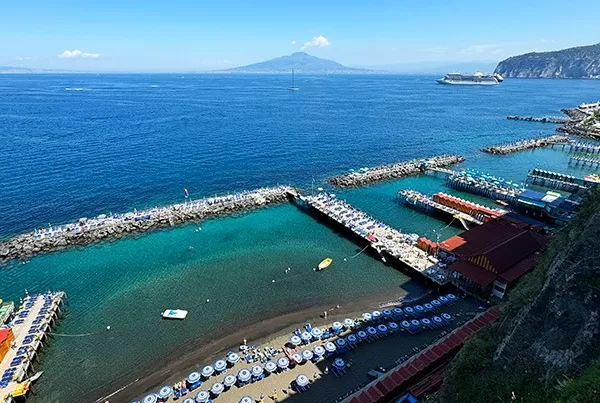📍 Explore Campania:
The ruins of the ancient city of Pompeii hold some of the best-preserved Roman artefacts anywhere in the world, but are also one of the most visited sites. A lot of people ask me about visiting Pompeii as it is one of those must-see sights, and after years of spending time at the ancient ruins, I am here to answer all your questions! From understanding how to navigate the archaeological park, what there is to see and how to get hold of tickets, here is my guide on how to visit Pompeii.
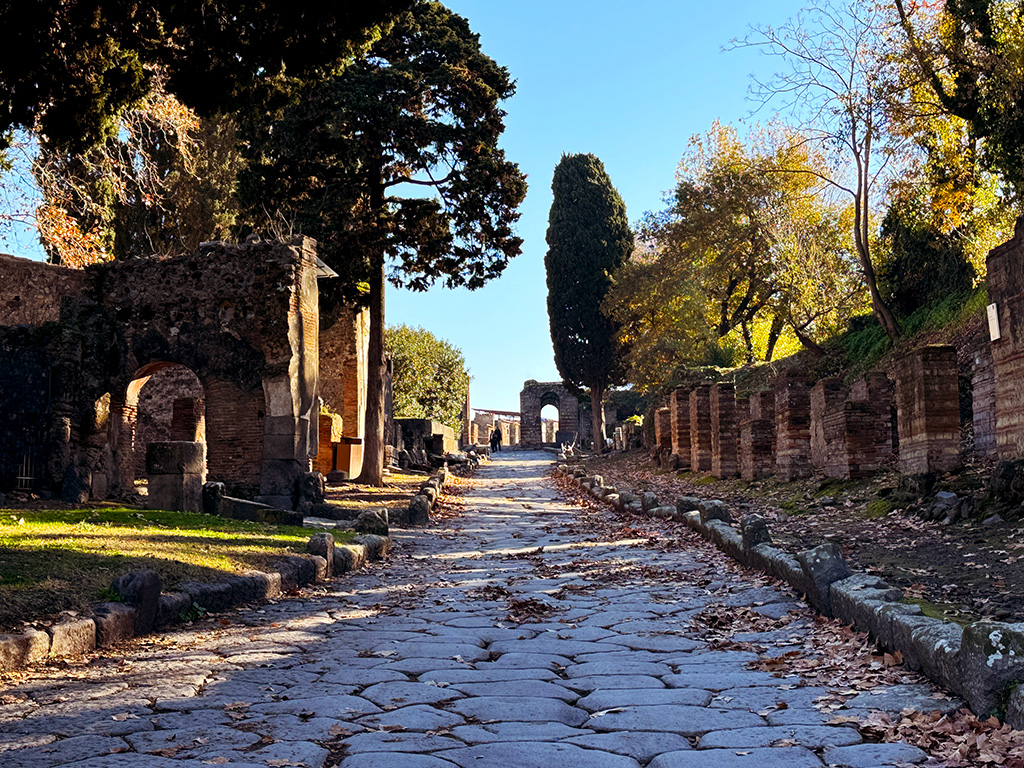
The world’s most famous archaeological site is waiting for you – let us share the best way to visit Pompeii
Everything You Need to Know to Visit Pompeii
There is a reason why millions of people visit Pompeii each year. Yes, Pompeii can feel very busy at times, but getting to look back in time and see what the city was like on the day of its destruction is something truly special.
I have visited many ancient sites all over Italy and Europe, but none of them feel the same as Pompeii. The sheer size of the excavated area, the details of people’s everyday lives and of course the evocative story of Mount Vesuvius’ eruption destroying the city all combine to create a unique visit experience.
In this guide I’ll be helping you have your own amazing experience, covering these topics:
My Number 1 Pompeii Visit Top Tip
Pompeii has a well-earned reputation for being busy and crowded. This is because most of the big tour groups and online guides take people along the same route around the most central parts of the site. The paths between the Forum and the brothel, to the House of the Faun and then to the theater are therefore pretty packed, especially in the mornings.
My top tip is to avoid those main paths and walk along the smaller ancient streets. The grid-pattern of the ancient town makes it simple to go along parallel roads and then cut in where you need to. Be sure to have a copy of the official map to refer to as well.
In general, outside of the most central area, Pompeii is not that busy. Be savvy about your explorations and you’ll have a much more enjoyable time!
The History of the Pompeii Archaeological Park
Pompeii is known as an ancient Roman city, but its origins go back much earlier.
Ancient Pompeii
Like nearby Herculaneum, Pompeii was originally founded by the Oscans, a native tribe from Campania, near a major river. Starting off as a small village during the 8th century BCE, Pompeii quickly became wealthy thanks to its port. Influenced by the arrival of the ancient Greeks, the settlement grew, building temples and expanding its size, as well as adding a city wall.
Through the next few centuries Campania was under the control of various different peoples. As well as the Greeks, the Etruscans from further north in Italy and Samnites from central Italy vied for control of these lands. Not only did the easy access to the Mediterranean make the region good for trade, but the soil was fertile and there were lots of resources to fight over.

Pompeii’s strategic position in the Bay of Naples, along with the famous fertility of the surrounding area, made it a melting pot of cultures during antiquity
However all of these tribes were ultimately to fall under the influence of the emerging ancient Romans. Through the 4th and 3rd centuries BCE there was a series of conflicts involving Rome, which left the city of Pompeii under their control but also still allowed to rule itself mostly independently.
This all changed in the 1st century BCE when Pompeii joined in a coalition to rebel against Roman control. The so-called Social Wars did not end in victory for Pompeii and the other cities, with the Romans taking direct control and making them official colonies.
Roman Pompeii
During the Social Wars Pompeii had been besieged and many buildings had been damaged or destroyed. Once the Romans took control of the city, repairs and improvements were done on a large scale, including the addition of the amphitheatre and a refurbishment of the Forum.
Rome was determined not to lose control again, changing the official language to Latin, settling many veteran soldiers of the Roman army nearby and forcing the Pompeiians to follow Roman customs. This led to a sort of rebirth for the city, which was still a strategically important port.

Pompeii was a wealthy town, evidenced by the ornate frescoes and ancient artwork found throughout the site
Goods flowed through Pompeii up to Rome and many wealthy Romans built properties in and around the city. After the first emperor, Augustus, took complete control of the empire in 30 BCE, further improvements were made to Pompeii, including a connection to the new Aqua Augusta aqueduct that provided the city with running water.
All of this would come to disaster however, thanks to Mount Vesuvius.
Vesuvius Eruption
Had the people of Pompeii known more, they would have been aware of the warning signs. A severe earthquake had rocked Campania in 62 CE, causing lots of damage, and further small tremors continued to ripple through the land. Reports of giants walking the slopes of Vesuvius, mysterious animal deaths in the grazing herds, rockfalls and more were all common, but no-one knew what they signified.


Prior to the eruption in 79 CE, records – both written and scientific – suggest that Mount Vesuvius was far taller, with a more conical shape. The force of that eruption blew a huge part of the volcano away, creating the shape we see today.
When the volcano suddenly erupted, it was around midday. An immense column of dark ash and pumice shot up into the air, spewing high volumes of debris onto the land around it. Pompeii was directly underneath this cloud, meaning the city started to be hit almost immediately.
People started to flee (the relatively small number of bodies identified to date indicates that most residents were able to escape). All day Pompeii was battered by the debris, starting to bury the city and causing roofs and walls to collapse, but there was more to come.
The next morning Pompeii was hit by a series of powerful pyroclastic flows, killing anyone who had managed to shelter overnight and burying large parts of the city. Ash and pumice continued to fall for another few days, leaving only the tips of a few columns and the very tallest buildings visible.
Initially it appears as if there were some attempts at salvaging building materials, as well as opportunists searching the ruins, but Pompeii was never rebuilt. Slowly it was forgotten, and when later eruptions in the 4th century added even more volcanic debris, the city ruins were completely covered.
Rediscovery and Excavations
Pompeii lay untouched for centuries. It was not until the 1700’s that parts of the city saw light again. The Neapolitan Bourbon kings had become fascinated with ancient ruins and the history of the region, digging to reveal parts of Herculaneum in 1738.
Further digs were done in places where historians thought ancient towns would be, and in 1748 the first official dig was done at Pompeii – although they didn’t realise it was Pompeii until 1763 when they found an ancient inscription.

Many of the most impressive finds from Pompeii (and Herculaneum) are on display at the MANN in Naples – be sure to visit this incredible museum during your trip for the complete Pompeii experience
Pompeii was an easier site to excavate, so much more of the ancient city was uncovered here through the 18th and 19th centuries. Precious frescoes, statues and mosaics were taken away for the royal family to admire (now much of this collection is in the MANN) and the method of pouring plaster into voids in the ash layer to study the people who died here was devised.
Excavations continued on and off through the 20th century, and in 1997 Pompeii was classified as a UNESCO World Heritage Site. Today excavations and studies continue but the focus is on the areas already exposed rather than digging out even more of the city.

A great example of modern conservation efforts at Pompeii is the Villa of Mysteries, where the frescoes have been restored to their original glory
The Best Time to Visit Pompeii
The best time to visit Pompeii depends on two things, visitor numbers and the weather.
If your main concern is avoiding the crowds, you should go at the time of year when Naples and Campania visitor numbers are at their lowest – in November, early December, late January and February. At these points, there are a lot less people in the archaeological park so you can get last minute tickets and make the most of the empty streets.
These wintery months are not the best weather-wise however. When it rains the ancient paving stones get slick fast and the site is just not as enjoyable when it is cold. I have been in December when the sun was shining which was admittedly pretty great, but it’s hard to know in advance if the weather will be cooperating when you visit!

We love visiting Pompeii in the winter when the weather is good; there is something magical about the way the light highlights the ancient ruins
In the summer Pompeii is at its busiest, but it is also extremely hot. I’ve set out my summer travel tips below if you can’t avoid visiting at this time of year, but if you can avoid it, do.
In late spring and early fall the visitor numbers are still high, and daily temperatures climb fast. So, for me, the best time to visit Pompeii is in March or October. At these points of the year you will have the best balance of crowd volumes and the weather. Temperatures are on the cooler side and there is more of a breeze, plus the number of people visiting is a little lower.
Pompeii is never really quiet, but in March and October you will have no problem seeing everything you want to.
How to Visit Pompeii in the Summer Months
Summer is when Campania is at its busiest, with people looking to enjoy the sea and sun in Sorrento, on Capri or along the Amalfi Coast. A lot of those people ask us about doing some sightseeing at the same time, so here’s how to make sure you don’t have a bad experience at Pompeii during peak season:
1. Book The Earliest Entrance Time
The earliest entrance time for Pompeii is 9AM, so book your tickets for this time slot. This is earlier than most tours start or cruise ship groups start to arrive, so you won’t have to deal with the large groups. Plus you can get into the archaeological site and see some of the most popular sights before the crowds build.
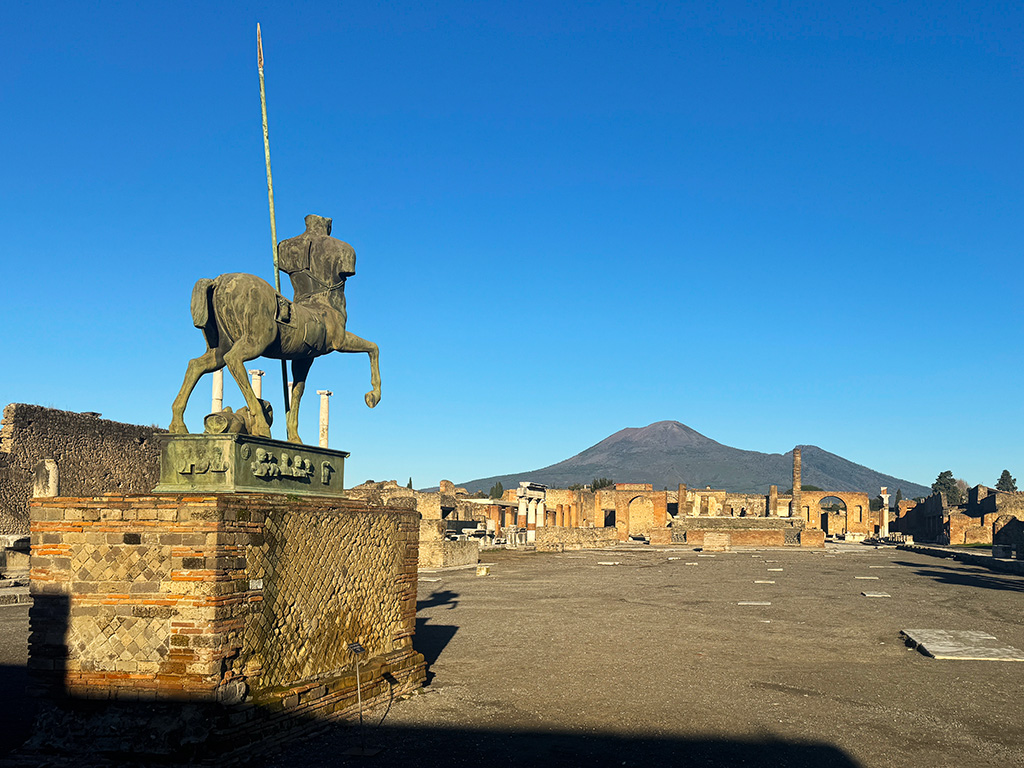
If you can be one of the first through the gates at opening time, you’ll enjoy epic views like this of Pompeii before it fills up with more guests
2. Travel Early
Don’t plan your travel to arrive at the Pompeii site entrance for 9AM, but rather 8.30AM at least. There are 3 reasons for this, firstly you want to leave yourself some time in case of delays with your transport. Secondly, traveling earlier means traveling when it is a little cooler – an hour makes a big difference in the hot Italian summer!
Finally, if you arrive with time to spare you can grab an ice cold water before you go inside and wait in the shade calmly. Rushing off the train or jumping out of a taxi and feeling under pressure will only make you feel hotter. It’s better to wait for a little bit and make sure you are at a comfortable temperature before going inside.
3. Bring Plenty of Water and Snacks
In the heat you will need more water than you think, but also will need to replenish your minerals and salt levels. Food and drink options inside Pompeii are not widespread so it’s essential to have supplies with you. Water, electrolyte packets, snacks like protein bars or fruit, prepared sandwiches – these will all come in very handy!
4. Do Not Go at the End of the Day
In summer Pompeii is open until 7PM, so often I see recommendations telling people to leave their Pompeii visit for the afternoon when it’s quieter. From first-hand experience, this is not a good idea!
Yes, it generally is a little quieter after 3PM, and the afternoon light on the ancient buildings is gorgeous. However, the heat on summer afternoons in Pompeii is intense. The sun has been beating down on the site all day and there is nowhere for it to go. Afternoons are much hotter, plus it means you will probably be on a train or in a taxi at the hottest point of the day to get to Pompeii so it’s just not enjoyable.
How to Get to Pompeii
The most convenient and reliable transport option for reaching the Pompeii Archaeological Park is by train, if you’re coming from Naples or Sorrento. If you’re coming from further away, such as the Amalfi Coast or Rome, then the public transport options involve multiple journey legs. Or, you can arrange for a private driver or taxi for a more direct option.
Getting to Pompeii by Train from Naples
There are technically 3 train lines that run from Napoli Centrale to Pompeii, but the main one is the Circumvesuviana line that goes between Naples and Sorrento. This line has a stop at the Pompeii Scavi Villa Dei Misteri station, which is close to the main entrance of the archaeological site and where most tours start from.
The other 2 lines are the intercity route between Naples and Salerno and EAV’s Line 4 Naples-Poggiomarino route.
These stop at different stations in Pompeii, the first at the modern town named, somewhat confusingly, as simply ‘Pompei’ and the other at the station of Pompeii Santuario.
Both of these are a short walk to the park entrance at Piazza Anfiteatro.
I recommend using the Circumvesuviana line, specifically the Campania Express if the times work with your planned visit times.
This is because the Pompeii Scavi station is better situated and the Circumvesuviana line runs more regularly.
Getting to Pompeii by Train from Sorrento
From Sorrento, you can only take the Circumvesuviana train. This always stops at the Pompeii Scavi station and as it starts in Sorrento, you can’t get it wrong! If you are able to book the Campania Express I would suggest doing so, it is a nicer train and will get you to Pompeii faster.
For all up to date EAV train schedules for both Line 1 and Line 4 (to/from Naples), check out the official site by clicking the button below.
Click to expand the details for the ‘Vesuvian Lines Timetable’/’Orari Linee Vesuviane’ and then download the PDF document for the line you are interested in.
Other Transport Options
Apart from these trains, your only other options for reaching Pompeii are by road.
You can drive yourself if you have a car, but the lack of parking makes this a bad option. You can arrange for a taxi or private driver, but rates for this can vary hugely so always check the prices in advance and make sure you’re happy before setting off.
My recommendation if the train isn’t an option is to book a tour or experience that includes transportation to and from Pompeii. Some of these are just for Pompeii itself, some include other sites like Herculaneum and Mount Vesuvius, some are paired with entrance tickets and others guided tours; so you can do choose precisely what sort of experience you want!

There is a small taxi rank close to the Porta Marina entrance to Pompeii, opposite the Pompei Scavi Villa Dei Misteri train station
Organize your transport easily and stress-free for any trip to Naples and Campania:
Everything you need to know about getting around Naples can be found here
What to See in the Pompeii Archaeological Site
The Pompeii Archaeological Park is vast, bigger than most other ancient sites I’ve visited. So, while in theory it’s possible to walk around each section in a full day, this is a lot for anyone who isn’t a passionate ancient Roman scholar.
The Pompeii site is divided into nine regions, labelled with Roman numerals on the site maps and guides. These were established by the archaeologists who excavated the site, not the original inhabitants, but are a convenient way to divide up the large area.
Here I’ve broken down what to see in each region to help you plan what areas to concentrate your time in – any closures are displayed at the entrance on screens so check these when you arrive:
Region I
Region one is between Region two and eight, on the southern side of the site. Unlike other regions, some of the homes found here belonged to less-wealthy people, so they aren’t as large or grand as others I talk about below. This is why I like it so much!
Seeing a merchant’s home and how it was connected to his thermopolium (a type of bar serving hot food as well as drinks) in the House of Vetutius Placidus makes it much easier to imagine the lives of these ancient people.

It’s easy to imagine this thermopolium lively with clients grabbing their lunch from the bar counter, not too much unlike an Italian tavola calda these days!
There are plenty of more ornate and wealthy homes in this region too, including the House of the Citharist (one of the largest anywhere in Pompeii) and the House of the Lararium of Achilles with frescoes representing scenes from the Trojan War.
In Region one you can also visit the Garden of the Fugitives, which is where 13 victims were found, killed as they were trying to escape. Here you can see the casts of their bodies all together.
Region II
The main attraction of Region two is the Amphitheater. Built in 70 BCE, this is one of the oldest amphitheatres anywhere, and while nowhere near as well preserved as the Colosseum in Rome, it is pretty impressive!
Nearby you can also visit the House of Venus in the Shell which has a huge fresco of the goddess, and the Porta Nocera, an ancient gate in the city walls.
This is where the Piazza Anfiteatro entrance is located, and I like this part of the archaeological park because there are more green and shady areas.

Unlike the Colosseum in Rome, you are free to walk around the arena floor without restrictions at Pompeii’s amphitheatre
Region III
Region III is a small area on the east edge of the archaeological park. This is the quietest area without much in the way of big things to see, but I like it because you can walk up to the Porta di Nola. This was one of the ancient city gates, dating back to the earliest Oscan origins of Pompeii.
Region IV
Region four is off-limits to visitors currently, as it has not been safely excavated yet. We’re hearing exciting rumours of finds here but for now, we cannot explore it.
Region V
Region five is on the north side of the park, and is where a lot of the current archaeological work is ongoing. Therefore, the area that you can visit here is smaller, and more often subject to closures because of this work.
If you have the opportunity to go inside, the House of the Silver Wedding has some of the most beautiful frescoes. The House of Marco Lucretius Frontone is also wonderful, filled with marble, frescoed walls and a gorgeous table with lion-paw shaped legs.
At specific places around the archaeological site you will be able to see the body plaster casts.
These have been created by injecting plaster (or resin in more recent times) into the voids left in the ground when bodies of the Pompeii victims have decomposed. There are no human remains on display, but the casts are no less moving when you think of what they represent.
Please be respectful when looking at these casts and if you are travelling with children, prepare them for what they will see. I have witnessed parents having to console their kids because they were scared, so it’s important to be mindful of this.
Region VI
Region six covers the northwest corner of the site. Here you’ll find primarily villas and homes, as it was a residential area of Pompeii.
The House of the Faun is huge, with large rooms that you can explore and the lovely internal courtyard. Replicas of the bronze faun statue and intricate mosaics found here give an idea of the richness of this house – the originals are now in the MANN museum.
There are plenty more houses, each with their own unique style. The Villa of Diomede has a stunning garden area, the House of the Small Fountain has colorful mosaics dotted with seashells, and the House of the Tragic Poet has one of my favorite details – a mosaic of a barking dog with the message ‘CAVE CANEM’ which means ‘Beware of the dog’!

The House of Diomede has new residents now…
You can see some of the best frescoes in Pompeii here, at the House of Castor & Pollux, the House of the Vettii and of course, the remarkable Villa of the Mysteries. You have to purchase the Pompeii+ ticket to get inside the Villa of the Mysteries, but I think it’s absolutely worth paying a little more to see it!
Region VII
This is the region where most visitors tend to concentrate their time. If you enter via the Porta Marina entrance, this is the first part of the site you will see and is home to the most well-known sights.
Firstly you will see the huge Forum with the Temple of Jupiter at one end. Most people rush in, take a picture and move on, but if you move down closer to the temple end and take a moment to look around, the scale of Pompeii will start to reveal itself.
Behind the temple you can see the looming presence of Vesuvius – the first time I stood here it was genuinely jaw-dropping to see the ruins framed by the huge volcano!
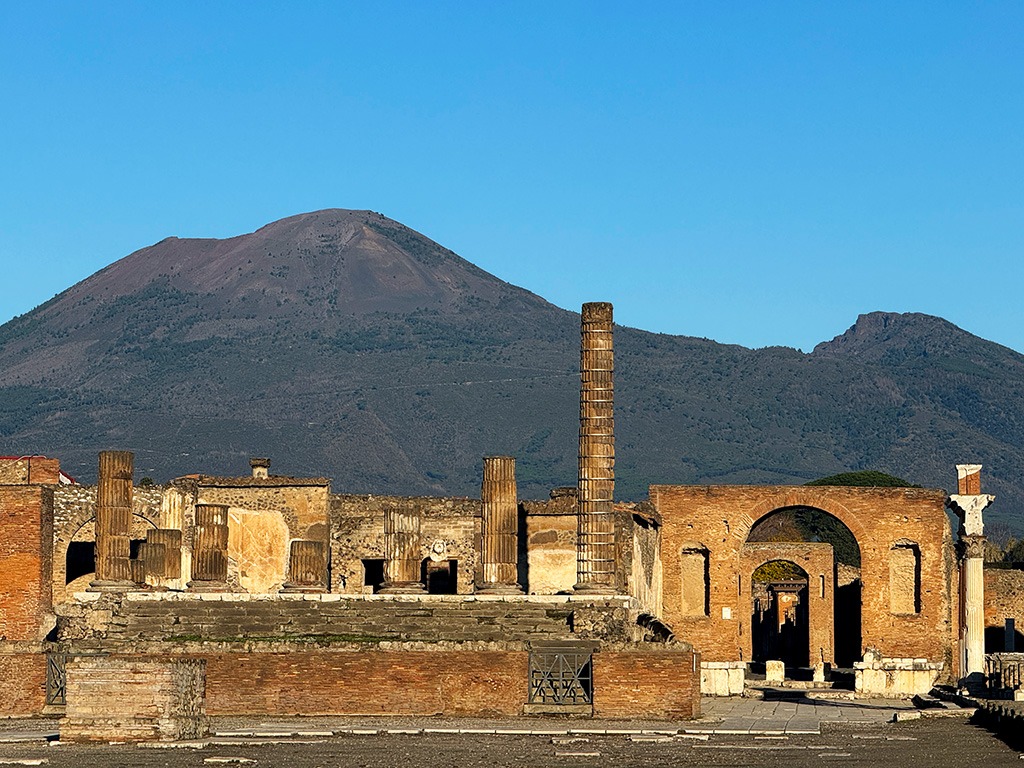
Few places are as evocative as Pompeii – stand in the Forum and take in the view of Mount Vesuvius behind the ruins for a few minutes when arriving
The buildings close to the Forum were all very important, so you can see the Sanctuary of Apollo, the Granary, the Forum Baths and various temples. This is also where you will find the Brothel (also called the Lupanar) and ruins of homes owned by the very wealthy residents of Pompeii.
Region VIII
Region eight is located along the southern edge of the archaeological park, from the Sanctuary of Venus along to the Large Theater (not the amphitheatre). Some of the most important buildings of the ancient city were located here so I highly recommend spending some time here.
First up is the Basilica. In ancient times a basilica was where the business of a city was done, but the layout was copied for early churches which is why we use the word today. You have to use your imagination a little, but the remains of the large columns, double-height walls and big square footage make it clear how impressive a building it would have been.
It is in this region that you can see the ruins of a Doric temple, dating back to the Greek influence on Pompeii, as well as the Temple of Isis and a number of houses.

Pompeii’s theatre is one of the best examples of an ancient entertainment venue still standing today, anywhere in the world
The most important structures in this region however are the two theatres, the Large Theater and Small Theater (or Odeon). The large one was built much earlier than the small one, but both would have been used for musical and theatrical performances. Walk up the steps and take a seat on the ancient stonework for a perfect mid-exploration break!
Region IX
This is the most central region, so you will definitely walk past it at some point during your Pompeii visit. In this region you’ll find the largest bath complex in the site, the Central Baths, as well as some of the largest and most ornate houses.
The House of Marcus Lucretius in Via Stabiana has some lovely mosaics and fresco remnants as well as a beautiful garden and fountain. Don’t miss the House of Obelius Firmus whose facade is huge, with a similarly large interior or the House of Julius Polybius with its magnificent fresco.
Practical Visit Information
Apart from December 25 and January 1, the Pompeii Archaeological Park is open every day. As it is still an active archaeological site, sometimes specific areas or houses are closed, but these are listed on the official website and on screens at the entrance.
Once you are inside the site you cannot leave and re-enter so make sure you have everything you need with you. This includes water and snacks, as the refreshment options inside are pretty limited.

There is a small bistro/cafe in the centre of the park, accessed via Via dell’Abbondanza offering simple snacks and light refreshments. Note that this can get very busy during the summer months, so be sure to bring food and drink with you if possible.
Think about appropriate accessories for the weather when you visit too; umbrellas and rain jackets for the cooler months, sun hats and sunscreen for the summer. The one year-round essential is good shoes, that will be comfortable and supportive on the ancient city streets.
The earliest entrance time is 9AM year-round but the closing time varies according to the season so be sure to check the opening hours on the official site here in advance.
Click to view the essential things you should always have when traveling:
Accessibility
The ‘Pompeii for All’ itinerary is designed to allow anyone with mobility challenges, including wheelchair users and parents with prams/buggies to safely and comfortably see the major points of interest in the archaeological site.
There are multiple routes of different lengths covering different regions of the site, including accessible bathrooms, water fountains and access to the cafe.
To find out more about the routes and facilities, take a look at the official site here for lots more information.

Efforts have been made to improve the accessibility of Pompeii throughout the site for those with mobility challenges, including the placement of crossing points as shown here
Visiting Pompeii with Kids
Pompeii with children is a challenge, especially if they are on the younger side. Outside of the routes mentioned above, taking a buggy or pram is challenging, there is very little shade or areas where you can take a break and the site is so large little kids will tire fast.
With older children it is more manageable, but make sure to bring plenty of snacks and water to keep them going.
Be aware of the areas that are unsuitable for kids, such as the brothel and displays of body plaster casts that can be upsetting. These are only a small element of the overall site so you can easily avoid them if you know where they are!
There are also kid-focused tours of Pompeii that you can book which are a good option.

Pompeii’s Antiquarium (museum) is free to access for all visitors with a valid ticket and a great location to take kids; it’s air conditioned, and showcases some of the everyday items found during excavations that help bring the site to life
Pompeii Tickets and Tours
There are a variety of different ticket options for Pompeii, including access and transport to other villas that were preserved after Vesuvius’ eruption. I would always recommend booking your ticket in advance, even in low season when you only need to book a day or two ahead. With the daily limit on visitor numbers a lot of people end up disappointed!
If it will be your first time in Pompeii I highly suggest joining a tour. There is so much to see and very little information/signage on site, so a guided tour with an expert is an excellent way to get more out of your visit.
For more about the different entrance tickets, tour options and how to make the most of your visit to Pompeii, check out our dedicated page here.
Discover Naples and Campania easily with this pass!
Access over 100 Naples and Campania sites, museums, archeological parks (including Pompeii) with the official tourist pass of the city and region! Save money and make visiting the top sites stress-free – click here to find out more:
How to Combine Your Visit to Pompeii With Herculaneum and/or Mount Vesuvius
You can easily visit Pompeii in combination with Herculaneum or Mount Vesuvius. Seeing all 3 in one day is more challenging but possible if you are really strict on timings and pre-book everything. I do not recommend doing all 3 sites in one go however, it’s a lot of information to take in and there is no simple public transport connection to travel between them.

Herculaneum is a much smaller site than Pompeii, but equally as fascinating and helps to evidence the history of this area further
On the other hand, doing two of the three is a good idea. If you’re interested in seeing a different type of ancient town and getting a sense of how deeply Vesuvius’ eruption changed the landscape, combine a Pompeii visit with Herculaneum. If you’d rather get to know Vesuvius better and put Pompeii in perspective, visit the volcano crater before or after the archaeological park.
Combination Tours
The easiest way to see multiple sights in one day is definitely to join a tour. These take care of all the transportation as well as timings, entrance tickets and sometimes even lunch as well, making your day out run smoothly.
If you’re staying in Sorrento or on the Amalfi Coast these tours are a particularly good option, as the public transport connections are more limited from there.
Looking for inspiration? Check out these suggestions from our trusted partners to get you started:
- Meet your guide at Pompeii for a small group tour of the archaeological park before being driven to a vineyard at the foot of Mount Vesuvius for a traditional lunch and wine tasting
- This completely private and customisable day experience starts at Pompeii before heading to Herculaneum, showing you both towns destroyed by Vesuvius
- Visiting Naples on a cruise? Take this private shore excursion and visit both the crater of Vesuvius and Pompeii, with the option to add wine tasting and lunch at a local vineyard
- If you’re keen to see all three sites in one day, you can take this tour from Naples which starts in Pompeii before transporting you to the crater of Vesuvius and Herculaneum
- Staying in Sorrento? Take this small group day trip which includes guided tours of both Pompeii and Herculaneum as well as transport to and from Sorrento
Be sure to Pin this guide if you enjoyed it or found it useful!
Save this page by pinning it and be sure to follow us on Pinterest for more travel inspiration and guides:

To sum up…
Getting to visit Pompeii is a highlight of any trip to Campania or Italy, so by following the information in this guide, we hope you will have a fantastic trip. The main things to remember are to book your tickets or tour in advance, to bring plenty of water and snacks and to head away from the busiest routes to truly experience the magic of Pompeii.
For lots more Naples and Campania travel tips, tricks and recommendations, be sure to subscribe to our 100% free Napleswise newsletter. Subscribers also get exclusive discounts and perks from our friends and partners helping saving you money on your trip here!
Napleswise’s Top Travel Resources
Ready to book your trip to Naples and Campania? Take a look at these helpful links to friends and partners we use ourselves and trust:
🌊 Book your ferries between Naples, Sorrento, Capri, the Amalfi Coast and more here
🚕 Organise your airport transfer for a stress-free arrival
🛏️ Search for and book your perfect accommodation
🧳 Our complete guide to what to pack for Naples & Campania
⭐️ The number one travel accessory, a multi-point travel adapter and voltage converter
🏛️ Browse a huge range of tours in Naples, Pompeii, Sorrento and beyond
👌 Experience unique tours and special access to Naples’ most popular sights
💪 Protect yourself with comprehensive travel insurance
📱 Stay connected without incurring large fees with a reliable eSim
🔒 Find secure places to leave your luggage when exploring Campania
🚂 Plan your train journeys and purchase tickets all in one place


